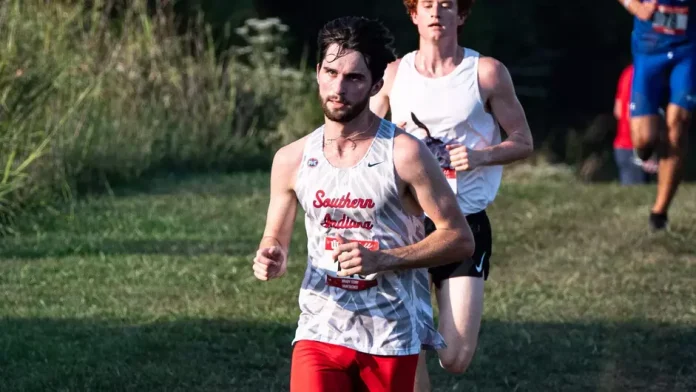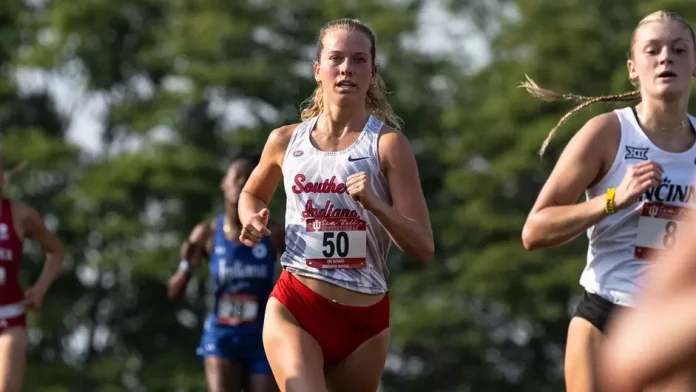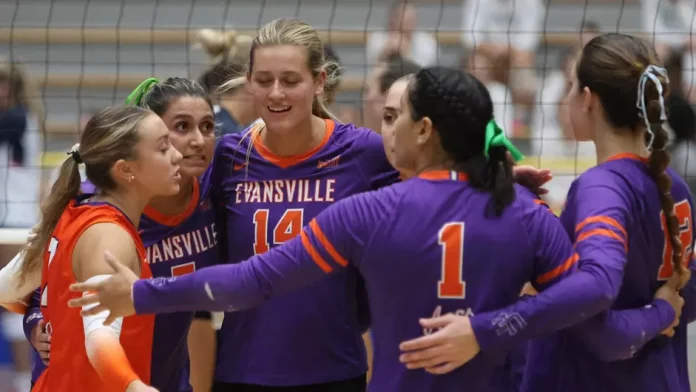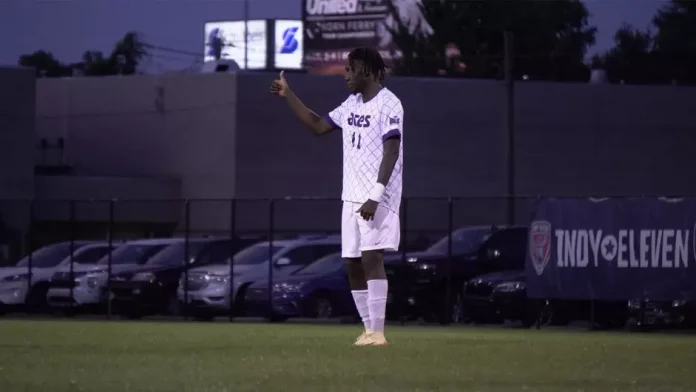UNION CITY, Tenn.—University of Southern Indiana Men’s Cross Country senior Brady Terry out-kicked Southeast Missouri State University’s Nick Cimmarusti down the stretch for a first-place finish out of 67 competitors at the University of Tennessee Martin OVC Preview Saturday morning.
Terry finished the eight-kilometer course in 24 minutes, 21.8 seconds, less than two seconds ahead of Cimmarusti, for his second-career win on the grass and his first since winning the Stegemoller Classic September 10, 2021.
As a team, the Screaming Eagles finished second out of six teams with 43 points, just two back of first-place SEMO.
Sophomores Jackson Collman and Alex Nolan finished ninth and 10th, respectively, to aid the Eagles’ efforts. Collman finished in 25:09.0, while Nolan carded an 8k time of 25:10.3
USI placed eight runners in the top 20, with junior Isaac Stanford and freshman Layden Wagoner were 13th and 14th, respectively, to round out USI’s top five. Junior Eli Mojonnier (16th) and freshman Zach Wells (19th) wrapped up the Eagles’ scorers, while sophomore Cole Hess was 20th.
The Eagles return to action September 27 when they travel to Columbia, Missouri, to compete at the University of Missouri’s Gans Creek Classic.
USI’s Terry wins UTM OVC Preview as Eagles finish second
USI women’s runners win UTM OVC Preview
UNION CITY, Tenn.—Sophomore Zoe Seward raced to a second-place finish out of 70 competitors to lead University of Southern Indiana Women’s Cross Country to a first-place finish at the seven-team University of Tennessee Martin OVC Preview Saturday morning.
Seward finished the six-kilometer course in 21 minutes, 44.7 seconds as the Screaming Eagles landed four runners within the top six finishers and six in the top 20.
Senior Audrey Comastri and sophomore Ellie Hall finished fourth and fifth, respectively, to aid the Eagles’ efforts. Comastri crossed the finish line in 21:57.6, while Hall finished in 22:03.1.
Freshman Hadessah Austin was just outside the top five with a sixth-place time of 22:06.7, while senior Katie Winkler rounded out the Eagles’ top five with a 17th-place finish.
Sophomore Emily Rempe and senior Emma Thompson were 20th and 25th to round out USI’s scorers.
As a team, USI finished with 34 points, 15 ahead of second-place Tennessee Tech University. Southeast Missouri State University’s Nova Ojutkangas won the race with a time of 21:17.5
The Eagles return to action September 27 when they travel to Columbia, Missouri, to compete at the University of Missouri’s Gans Creek Classic.
Aces drop weekend finale to Morehead State
UE home Tuesday to face USI
MOREHEAD, Ky. – Saturday’s finale of the Comfort Inn-Vitational saw the University of Evansville volleyball team fall to Morehead State by a 3-0 final at Johnson Arena.
Leading the Purple Aces we Giulia Cardona with 10 kills. Melanie Feliciano and Madisyn Steele recorded four apiece. Feliciano paced UE with nine digs while Lexi Owen had 17 assists. M.E. Hargan led MSU with 12 kills.
Set 1 – MSU 25, UE 19
Evansville had the early momentum, posting the first three points of the match as Giulia Cardona and Madisyn Steele opened with a block. Maddie Hawkins added an ace to extend the lead to 6-2. Four in a row by Morehead State tied the game at 6-6 before the Eagles used a 4-0 run to take their largest lead at 16-12.
UE would not be able to close that gap as MSU cruised to a 25-19 win to take a 1-0 lead.
Set 2 – MSU 25, UE 15
Kills by Cardona and Steele saw the Aces open a 4-3 advantage. MSU countered with four in a row to go up 7-4 before a huge run midway through the frame saw them extend the lead to 18-8. From there, they never looked back and took a 2-0 lead with a 25-15 win.
Set 3 – MSU 25, UE 10
Scoring the first five points of the set, the Eagles put forth a dominant effort to clinch the 3-0 sweep. Back-to-back aces from Brenna Bommer capped an 11-1 start to the frame. The Aces were unable to recover as the Eagles pulled away to clinch the match.
On Tuesday, the Aces welcome USI to Meeks Family Fieldhouse for a 7 p.m. match.
Women’s golf remains in 12th at Cardinal Cup
Standtke leads Aces in round two
SIMPSONVILLE, Ky. – Round two of the Cardinal Cup saw another freshman lead the University of Evansville women’s golf team as Louise Standtke had the low round of the day for the Purple Aces.
Standtke wrapped up round two at the University of Louisville Golf Course with a 2-over 74. Her 2-round tally of 152 is tied for 29th. Three strokes behind her is Mallory Russell. Her round of 78 has her tied for 45thplace with a score of 155. Russell had a 77 on Friday.
Kate Petrova and Elizabeth Mercer are tied for 56th with totals of 157. After posting a 79 in the opening round, Petrvoa had a 78 on Saturday. Mercer led UE with a 74 in the first 18 holes before carding an 83 in round two. Destynie Sherida lowered her score by five strokes, dropping from a 99 to a 94.
The Purple Aces remain in 12th place with a 621. They enter Sunday’s final round seven shots outside of the top ten. Western Kentucky and Rutgers are tied atop the team standings with a 588. Middle Tennessee State is third, just three strokes behind. Grace Lu of Rutgers continues to hold the individual lead. Her even round of 72 on Saturday has her two shots in front of the competition with a 141.
Sunday will mark the final 18 holes of the event.
Slow start hinders Aces men’s soccer in loss to Drake
What is the TEMPORARY PROTECTED STATUS (TPS)?
What is the TEMPORARY PROTECTED STATUS (TPS)?
COMPLIED BY CCO STAFF
SEPTEMBER 5, 2024
- TPS is a temporary immigration status granted to eligible nationals of a foreign state designated for TPS under the INA, or to eligible individuals without nationality who last habitually resided in the designated foreign state, regardless of their country of birth.
-
During the TPS designation period, TPS beneficiaries are eligible to remain in the United States, may not be removed, and are authorized to obtain EADs if they continue to meet the requirements of TPS.
- TPS beneficiaries may also apply for and be granted travel authorization as a matter of DHS discretion.
- To qualify for TPS, beneficiaries must meet the eligibility standards at INA section 244(c)(1)-(2),8 U.S.C. 1254a(c)(1)-(2).
- When the Secretary terminates a foreign state’s TPS designation, beneficiaries return to one of the following:
○ The same immigration status or category that they maintained before TPS, if any (unless that status or category has since expired or terminated); or
○ Any other lawfully obtained immigration status or category they received while registered for TPS, if it is still valid beyond the date their TPS terminates.
Processes for Cubans, Haitians, Nicaraguans, and Venezuelans
immediate family members may request to come to the United States in a safe and orderly way. Qualified beneficiaries who are outside the United States and lack U.S. entry documents may be considered, on a case-by-case basis, for advanced authorization to travel and a temporary period of parole for up to two years for urgent humanitarian reasons or significant public benefit. To participate, eligible beneficiaries must:
Have a supporter in the United States;
Undergo and clear robust security vetting;
Meet other eligibility criteria; and
Warrant a favorable exercise of discretion.
Individuals participating in these processes must have a supporter in the United States who agrees to provide them with financial support for the duration of their parole in the United States. The first step in the process is for the U.S.-based supporter to file a Form I-134A, Online Request to be a Supporter and Declaration of Financial Support, with USCIS for each beneficiary they seek to support, including minor children. The U.S. government will then review the supporter information provided in Form I-134A to ensure that they can financially support the beneficiaries they are agreeing to support.
See below for additional information on the processes and country-specific eligibility requirements. Additional information is also available on our Frequently Asked Questions About the Processes for Cubans, Haitians, Nicaraguans, and Venezuelans page.
Temporary Protected Status
SPECIAL: Economic Trends in Evansville, Indiana
Economic Trends in Evansville, Indiana: A Look at Wages, Inflation, and Purchasing Power from 2020 to 2024
BY JOE WALLACE
SEPTEMBER 10, 2024
The Evansville, Indiana Metropolitan Statistical Area (MSA) has experienced significant economic shifts from January 2020 to August 2024. This period has been marked by changes in unemployment rates, average wages, and inflation, all contributing to a notable impact on the purchasing power of residents. Below, we explore these metrics and their implications on the region’s economic health.
Key Economic Metrics
| Metric | January 2020 | August 2024 | Change |
|---|---|---|---|
| Unemployment Rate | 3.4% | 4.5% | +1.1% |
| Average Wage | $21.60/hr | $23.10/hr | +6.94% |
| Inflation Rate | 0.1% (2020) | 4.82% annually | Total: +20.74% |
| Purchasing Power | -13.8% |
Unemployment Rate
The unemployment rate in Evansville increased from 3.4% in January 2020 to 4.5% in August 2024. This rise reflects broader economic challenges, including the pandemic’s impact, which initially spiked unemployment across the nation. Although the current rate indicates some recovery, the lingering effects have kept unemployment above pre-pandemic levels, suggesting that the job market in Evansville has not fully rebounded (FRED St. Louis Fed)
Average Wage Growth
Average wages in the Evansville MSA have seen modest growth, increasing from approximately $21.60 per hour in 2020 to $23.10 per hour by 2023, representing a 6.94% rise. While this increase seems positive, it is essential to contextualize wage growth within the broader economic environment, particularly considering inflation’s impact on real income. Nominal wage growth without corresponding adjustments for inflation can lead to misconceptions about improved economic conditions.
Inflation and Its Impact on Purchasing Power
From 2020 to 2024, inflation in the Evansville area averaged about 4.82% annually, leading to a cumulative increase of approximately 20.74% over this period. This inflation rate reflects national trends, where the cost of goods and services has outpaced wage growth, driven by factors like supply chain disruptions, increased demand, and broader economic uncertainties.
The inflation rate’s impact is seen starkly when comparing wage growth to the inflation rate. Despite the 6.94% increase in average wages, inflation’s cumulative effect has significantly eroded purchasing power, resulting in a net decrease of 13.8%. In other words, while workers in Evansville are earning more in nominal terms, their ability to purchase goods and services has diminished, highlighting the critical challenge inflation poses to household budgets.
Calculating Purchasing Power Change
To understand the change in purchasing power, one must subtract the inflation rate from the wage increase. In this case, a 6.94% wage increase against a 20.74% inflation rate results in a purchasing power decrease of approximately 13.8%. This calculation reveals that the cost of living in Evansville has outpaced wage growth, reducing the real value of earnings and squeezing household finances.
Implications for Residents and Policymakers
The declining purchasing power in Evansville is a clear signal that wage increases alone are not sufficient to keep pace with rising costs. For residents, this means tighter budgets and potentially difficult choices about spending. For policymakers and business leaders, the data underscores the importance of addressing wage stagnation and inflation. Efforts could include targeted economic policies to support wage growth, incentives for businesses to increase productivity, and measures to manage inflation pressures.
Conclusion
Harvest season is here; Dept. of Ag shares tips to stay safe around farm equipment on roads
INDIANAPOLIS — Harvest season is officially underway for Indiana’s 94,000 farmers, which means more slow-moving farm equipment will be on Indiana’s rural roads and highways. To keep Hoosiers safe this year, state agencies are asking motorists to be alert and patient, as they share the road with farm equipment this fall.
“The fall is an exciting time for all Hoosiers as the temperatures cool and the leaves turn colors. And Hoosier farmers share that excitement as they prepare to begin harvest,” said Lt. Gov. Suzanne Crouch, Indiana’s Secretary of Agriculture and Rural Development. “While traveling rural roads and highways this fall, remember to watch for large farm equipment moving between fields as they work to harvest the crops, and be sure to know the proper steps to safely navigate around.”
In 2022 four vehicles were involved in crashes with farm equipment in Indiana which resulted in one death, according to the National Highway Traffic Safety Administration.
“Moving farm equipment can be one of the most dangerous parts of a farmers job,” said Don Lamb, director of the Indiana State Department of Agriculture. “When motorists know how to safely navigate around farm equipment, our roads are safer. By working together, farmers and everyday Hoosiers can ensure they arrive safely to their destination.”
Farm equipment during harvest season could include tractors, combines, grain carts, grain wagons and large trucks hauling agricultural products. These vehicles are wide, sometimes taking up most of the road, and often travel at speeds no greater than 25 mph.
The following list includes several safety tips for motorists approaching large farm equipment:
- Farmers will pull over when they are able to let motorists pass, but it may take time for them to get to a safe place to do so.
- Be alert. Farm equipment is wide, sometimes taking up most of the road.
- Be careful when passing. Do not pass in a designated “No Passing Zone” or within 100 feet of any intersection, railroad grade crossing, bridge, elevation structure or tunnel.
- Do not try to pass a slow-moving vehicle on the left without ensuring that the vehicle is not planning a left turn. It may appear that the driver is pulling over for you to pass when it is actually preparing to turn. You will drive right into its path, endangering yourself and the farmer.
- Avoid tailgating, as some farm equipment might have to make sudden stops along the road.
- Allow plenty of time to get to a destination, be aware of alternate routes and avoid distractions.
“When you see farmers out working and moving from field to field, please be patient as they work to harvest their crops which are needed to help feed our communities and the world,” said Doug Carter, Indiana State Police Superintendent. “Let’s all work together to help ensure everyone’s safety on our roadways.”










